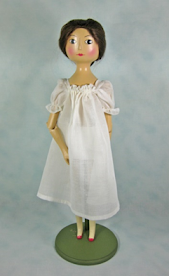2010 will focus on the earliest historic period represented by my dolls. This period runs from the time of the American Revolutionary War (1776) up until the era immediately preceding the American Civil War (1860). In this time period, the dolls were carved from wood or molded from paper maché. At the very end of this period, dolls with china heads began to appear. The bisque-headed dolls that dominated the next fifty years would not appear for a few years more. The earliest doll from this historic period in my collection is Charity, a doll carved from wood, described below.
Queen Anne dolls were used as a marketing tool in the century before the American Revolution. Merchants would dress the dolls in miniature versions of clothing by design and made in European fashion centers and then ship the thus-dressed dolls through their country and abroad to show potential buyers what the current styles were. In England, the dolls used in these marketing ploys were called Queen Anne dolls. In France, they were known as Pandoras. And in colonial America, they were called French babies. It should be noted that the dress worn by Charity, my Queen Anne doll, probably does not represent the height of couture in England, France, or colonial America.
The photo below shows is the way that Charity came to me. She was designed by Fred Laughon, who was well-known for his Queen Anne dolls and doll furniture. She was produced for the 46th annual convention of the United Federation of Doll Clubs, which was held in Philadelphia in 1995. Charity is a 14 inch tall peg wooden “Queen Anne” style doll. Her features are painted and she has a mohair wig that is styled into a bun at the nape of her neck. My Charity is number 1095 of 1510. It should be noted that the dress worn by Charity, my Queen Anne doll, probably does not represent the height of couture in England, France, or colonial America.
I have several other peg wooden dolls representative of this historic period. I think that this UFDC doll is very similar in construction to those other peg woodens and is pretty typical of the period. The clothes in which she came, however, bear very little resemblance to the gowns that colonial women actually wore.

This close-up of Charity’s face shows some of the characteristics typical of Queen Anne dolls. The features are stylized, with pale skin and eyes without pupils. Other features not seen in Charity include dotted eyebrows and “fake” beauty marks.
Here is Charity undressed. She is made of wood. Her arms are jointed at the shoulder and elbows with pegs. Her legs are pegged to her torso at the hips, and her knees are pegged as well. These pegs allows the movement of all these joints. The feet are very small compared to the rest of her body. She has painted white stockings and red slippers on her feet.
I realize that this is not a very good photograph. It was taken years ago with a very old camera. I would take another now, but for the fact that I only made one outfit for Charity and she is sewn into it. It would be a major project to get her out of it now and then back into it later.
One of my goals in dressing Charity was to make as authentic as possible 18th century clothing for her. The first undergarment that a colonial woman would put on is a chemise. At left Charity is wearing a typical chemise of that era. Unfortunately, the full sleeves did not fit under the dress that I eventually made for her, so I made another chemise with straight sleeves for her.
The next undergarment to be put on is the under-petticoat. Ladies often wore multiple petticoats, in part for warmth and also to support their very full skirts. Underclothing was usually made of linen and was white, for the ease of washing the garments.
Women of the colonial era usually wore a set
of stays under the bodice of their dresses.
Stays serve a function on human women, but have no effect on dolls
except to add bulk. To avoid that
outcome, I didn’t put stays on Charity.

The next undergarment is the outer petticoat. I made this for Charity out of quilted
fabric. The petticoats of colonial women
were often quilted for cold weather wear.
Here is the dress that I made for Charity. Colonial women often used striped fabric for
their clothing. Today, we would have
stripes running vertically down sleeves, but in colonial clothing, the stripes
were set to run horizontally around the sleeve.
The stripes were also often set to run diagonally on the bodice front,
which had the effect of making the waist look as small as possible.
The
back view of Charity’s dress shows the cartridge pleating that was used to
gather 40 inches of fabric into a 4 inch waist.
Cartridge pleats are gathered rather like old-fashioned ribbon candy. The bottom edge of the bodice is completely
finished, and then one edge of each cartridge pleat is catch-stitched to the
bodice.
Finally, here is a picture of Charity’s hat. This style was very common in colonial days,
usually made of straw. The photograph
changed the color of the ribbon somewhat.
In actuality, it is a close match to the color of the dress.







No comments:
Post a Comment